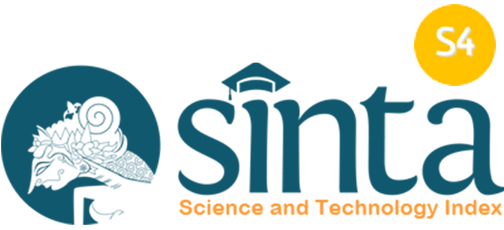PENGUNAAN NON-INVASIVE VENILTION (NIV) TERHADAP KESTABILAN SATURASI OKSIGEN DAN FREKUENSI NAFAS PADA BAYI ASFIKSIA DENGAN BBLR DI RUANG NICU RS PKU MUHAMMDIYAH GAMPING
Abstract
Abstrak
Asfiksia pada neonatus merupakan suatu kondisi dimana bayi yang baru lahir mengalami gagal nafas atau adanya kegagalan dalam petukaran gas dan transportasi oksigen, kondisi bayi yang mengalami asfiksia dengan berat badan lahir rendah (BBLR) yang merupakan kondisi kegawatdarurat yang memerlukan penanganan yang cepat. Pada bayi yang mengalami gangguan pada pernapasan bisa dilakukan peberian terapi dengan penggunan Non-invasive veniltion (NIV), yaitu alat bantuan ventilasi tanpa pemasangan tuba endotrakeal. Tujuan: untuk mengetahui terkiat dengan pengunaan NIV sebagai terapi untuk kasus asfiksia pada neonatus, sehingga bisa meningatkan kualitas hidup pada neonatus. metode: dalam penelitian ini mengunakan laporan kasus (case report) dengen pemberian intervensi pemasangan non-invasive veniltion (niv) pada pasien dengan asfiksia dan BBLR. Hasil: studi ini menunjukan bahwa adanya perubahan saturasi oksigen saat pertama dilakukan pemasangan ventilator, serta freuensi nafas membak setelah lakukan intervensi selama 6 hari. Kesimpulan: Penggunaan Ventilasi Non-Invasif (NIV) ditemukan memiliki dampak positif pada peningkatan saturasi oksigen dan laju pernapasan pada neonatus dengan asfiksia dan BBLR. NIV dapat berfungsi sebagai intervensi dini yang efektif di unit perawatan intensif neonatal (NICU).
Abstract
Neonatal asphyxia is a condition in which a newborn experiences respiratory failure or impaired gas exchange and oxygen transport. This condition, especially in infants with low birth weight (LBW), represents a critical emergency that requires prompt and effective intervention. One of the therapeutic approaches for respiratory distress in neonates is Non-Invasive Ventilation (NIV), a method of providing ventilatory support without endotracheal intubation. Objective: This study aimed to examine the effect of non-invasive ventilation (NIV) as a therapeutic intervention for neonates with asphyxia and LBW, and its potential to improve clinical outcomes and quality of life.Methods: This research employed a case report design, focusing on a neonate diagnosed with asphyxia and LBW. The intervention involved the administration of NIV, and the patient’s oxygen saturation and respiratory rate were monitored over six days. Results: The findings revealed a noticeable improvement in oxygen saturation immediately after the application of NIV. In addition, the respiratory rate showed significant stabilization after six days of intervention.Conclusion: The use of Non-Invasive Ventilation (NIV) was found to have a positive impact on improving oxygen saturation and respiratory rate in neonates with asphyxia and LBW. NIV may serve as an effective early intervention in neonatal intensive care units (NICUs).
Keywords
Full Text:
PDFReferences
Afifah, N., & Indarwati, F. (2024). Pengaruh Comfort Care Terhadap Peningkatan Paramter Fisiologi dan Kenyamanan Neontaus Dengan Asfiksia Sedang di NICU: A Case Report. An-Najat, 2(2), 111–121.
Agustin, W. R., Saputro, S. D., Zaidah, N. N., & Kusuma. (2023). PENGARUH PEMASANGAN NIV ( NON INVASIVE VENTILATION ) DAN HFNC ( HIGH FLOW NASAL CANNULA ) TERHADAP FREKUENSI NAFAS DAN SATURASI OKSIGEN PADA PASIEN HAPPY HIPOXIA TERKONFIRMASI COVID-19. Jurnal Kesehatan Kusuma Husada, 14(2), 104–113.
Ahmed, R., Mosa, H., Sultan, M., Helill, S. E., Assefa, B., Abdu, M., Ahmed, U., Abose, S., Nuramo, A., Alemu, A., Demelash, M., & Delil, R. (2021). Prevalence and risk factors associated with birth asphyxia among neonates delivered in Ethiopia: A systematic review and metaanalysis. PLoS ONE, 16(8 August), 1–21. https://doi.org/10.1371/journal.pone.0255488
Budiarti, I., Rohaya, R., & Silaban, T. D. S. (2022). Faktor-Faktor yang Berhubungan dengan Kejadian Bayi Berat Lahir Rendah (BBLR) di Rumah Sakit Muhammadiyah Palembang Tahun 2020. Jurnal Ilmiah Universitas Batanghari Jambi, 22(1), 195. https://doi.org/10.33087/jiubj.v22i1.1927
Damanik, D. W., Julwansa Saragih, & Riris Artha Dhita Purba. (2021). Studi Kasus: Asuhan Keperawatan Pada Pasien Dengan Asfiksia Neonatorum. Jurnal Ilmiah Keperawatan Imelda, 7(2), 116–123. https://doi.org/10.52943/jikeperawatan.v7i2.633
Firmansyah, I., & Lubis, M. (2016). Pemakaian Ventilator Frekuensi Tinggi pada Bayi Asfiksia Berat. Sari Pediatri, 5(4), 155. https://doi.org/10.14238/sp5.4.2004.155-9
Hendrawatia, S., Apsaria, A. P., Nurula, Nugrahaa, R. M., Salsabilaa, K. V., Syiffa Salsabila Rausanfikraa, 6, S. S. K., Astutia, Rabbania, H., Rahmaha, A. A., Divaa, J. A., Setiawana, S. A., & Cahyan, R. (2024). Terapi Oksigen untuk Pencegahan Hipoksia pada Bayi Prematur di Neonatal Intensive Care Unit: Sebuah Narrative Review. Jurnal Keperawatan Cikini, 5(2), 252–265.
Herikurniawan, H., & Audrey, J. (2024). Ventilasi Noninvasif pada Obstructive Sleep Apnea dan Obesity Hypoventilation Syndrome Noninvasive Ventilation in Obstructive Sleep Apnea and Obesity Hypoventilation Syndrome Ventilasi Noninvasif pada Obstructive Sleep Apnea dan Obesity Hypoventilation Sy. Jurnal Penyakit Dalam Indonesia, 11(3). https://doi.org/10.7454/jpdi.v11i3.1412
Kartika Sari, E., Sinaga, K., Saputra Surbakti, I., & Sinaga, A. (2025). Faktor-Faktor yang Mempengaruhi Kejadian Asfiksia Neonatorum di RSUD DR Tengku Mansyur Kota Tanjung Balai Tahun 2023. Jurnal Siti Rufaidah, 3, 21–35. https://doi.org/10.57214/jasira.v3i1.172
Nukuhaly, H., & Kasmiati, K. (2023). Penatalaksanaan Asfiksia Sedang Pada Bayi Baru Lahir. Jurnal Kebidanan, 3(1), 75–83.
Ramaswamy, V. V., Devi, R., & Kumar, G. (2023). Non-invasive ventilation in neonates: a review of current literature. Frontiers in Pediatrics, 11(November). https://doi.org/10.3389/fped.2023.1248836
Ridlo, A., & Khoeroh, H. (2024). PENATALAKSANAAN BAYI BARU LAHIR NY. P DENGAN ASFIKSIA SEDANG DI RUMAH SAKIT UMUM DAERAH BREBES. Jurnal Cahaya Mandalika, 644–648.
Sangsari, R., Saeedi, M., Maddah, M., Mirnia, K., & Goldsmith, J. P. (2022). Weaning and extubation from neonatal mechanical ventilation: an evidenced-based review. BMC Pulmonary Medicine, 22(1), 1–12. https://doi.org/10.1186/s12890-022-02223-4
Wudu, M. A., Wondifraw, E. B., Getaneh, F. B., Hailu, M. K., Belete, M. A., Yosef, S. T., Bekalu, Y. E., & Birhanu, T. A. (2025). Incidence and predictors of mortality among neonates admitted with birth asphyxia to neonatal intensive care units in Ethiopia: a systematic review and meta-analysis. BMC Pediatrics, 25(1). https://doi.org/10.1186/s12887-025-05481-3
DOI: http://dx.doi.org/10.30633/jkms.v16i1.3163
Refbacks
- There are currently no refbacks.
e-ISSN : 2540-9611
p-ISSN : 2087-8508
Publish by Stikes Syedza Saintika Padang(Jl. Prof. Dr. Hamka No. 228 Air Tawar Timur Padang)
Contact Person :
Ns. Honesty Diana Morika,M.Kep
Editor In Chief
Pusat Penelitian dan Pengabdian Masyarakat
STIKes SYEDZA Saintika Padang
Phone: 082384992512
Wiya Elsa Fitri, M.Si
Editor
Pusat Penelitian dan Pengabdian Masyarakat
STIKes SYEDZA Saintika Padang
Phone: 08116609525
Jl. Prof. Dr. Hamka No. 228 Air Tawar Timur Padang - Sumatera Barat
Email: lppmsyedza@gmail.com








This work is licensed under a Creative Commons Attribution 4.0 International License.
View My Stats





